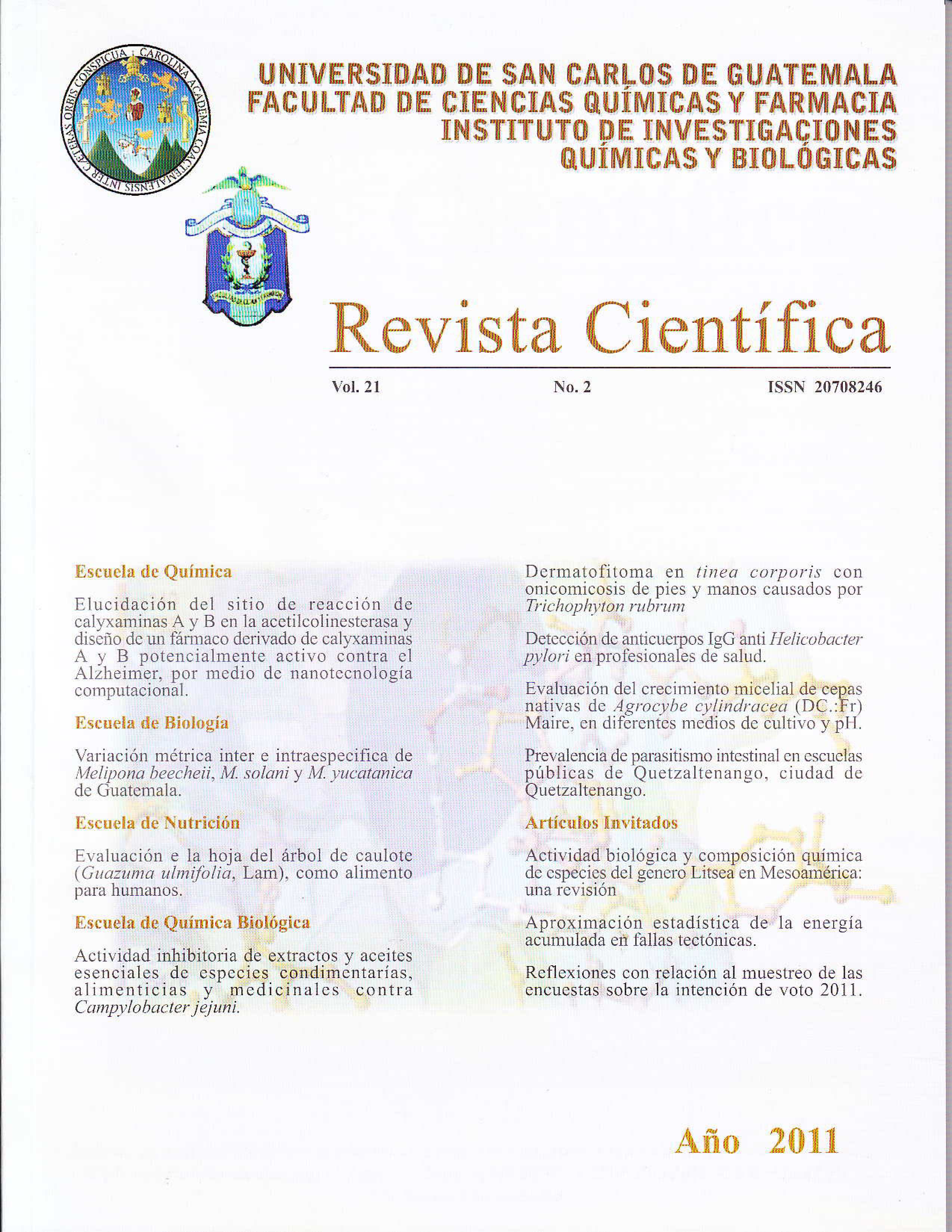Intestinal parasitoid prevalence in Public Schools of Quetzaltenango, Guatemala.
DOI:
https://doi.org/10.54495/Rev.Cientifica.v21i2.134Keywords:
commensal, intestinal parasitism, protozoan, coprologyAbstract
The objective of this study was to determine the prevalence of intestinal parasitism in school-age children at elementary level in four public schools in Quetzaltenango City, as well as to estimate the frequency of parasites base on genus and species, on all the school population, stratified by school year. To complain the objective, Peaces samples from students from 5-14 years-old were evaluated in the four schools (Escuela Oficial Manfredo Leal, Escuela Oficial Urbana Mixta “La Ciénaga”, Escuela de Sordomudos “Elisa Molina” y Escuela “Dr. Roberto Molina”), during the period o f May-August 2009. From a total of 500 students that participated in the study, 146 cases (29.26%) showed intestinal parasitism. The school grades with the highest parasitism were, in descending order: sixth year 38 cases (28.23%), first
year 30 cases (37.5%) and fifth year 24 cases (28.23%). The commensal protozoan species reported were: Endolimax nema (55 cases, 37.67%), Blasiocystis hominis (34 cases, 23.29%), Entamoeba histolytica (29 cases, 19.86% ) , Entamoeba coli ( 12 cases, 8.22% ) , Giardia lamblia ( 8 cases, 5.48%). Significant difference was determined among the school years with respect to the intestinal parasitism prevalence, p-value <0.05 (p=0.0281 ). Nevertheless, no significant difference wr as observed between the parasitism and
the population gender, p-value >0.05 (p=0.3393). With the present study, we determined that the prevalence (29.26%) of intestinal parasitism is a Public Health issue, on the infantile population studied; that may have several implications regarding health, such as low nutrient absorption, anemia, malnutrition, bile salts reduction and lesions on intestinal mucosa. It is recommended to cany out appropriate sanitary education, socioeconomic improvements through educational campaigns, microbiological evaluation of drinking water and food.
Downloads
References
Aguilar F. (1997). Parasitología Médica (3.ed.). Guatemala: Litografía Delgado.
Botero, D. (2000). Persistencia de Parasitosis intestinales endémicas en América Latina. Boletín de la Oficina Sanitaria Panamericana., 90:1-39.
Ellen J, Sydney M. (2001).Diagnóstico Microbiológica (8.ed), México: Panamericana.
Flores B, etal. (2004). Parasitologí Médica de las moléculas a la enfermedad. México: McGraw-Hill Interamericana.
Gil M. et al. (2006). Prevalencia de Parásitos Intestinales en estudiantes de establecimientos públicos y privados de nivel medio en el departamento de Guatemala. (Documento Técnico Estudiantes de 6to. Ciclo de la carrera de Química Biológica). Universidad de San Carlos. Guatemala.
Gonzáles C. et al. (2002). Parasitosisintestinal: aspectos clínicos epidemiológicos Centro de Salud Piedra Liza. Resúmenes del V Congreso Peruano de Parasitología. Perú
Ibánez H. et al. (2004). Prevalencia delenteroparasitismo en escolares de comunidades nativas del Alto Marañon, Amazonas, Perú. Revista Peruana de Medicina Experimental de Salud Pública: 21, 126-33.
Larrea M . et al. (2002). Prevalencia deenteroparasitismo en estudiantes del CEPN°054, en relación edad y sexo del distrito de Tumbes-Perú, durante el 2001. Resúmenes del V Congreso Peruano de Parasitología. Perú.
Menendez. E. (2003). Prevalencia deparásitos intestinales en niños de edad escolar de la escuela pública Alberto Mcjía de la zona tres de la Ciudad Capital y comparación del análisis coproscópico simple con el análisis coproscópico seriado para su determinación. (Tesis de graduación, Facultad de Ciencias Químicas y Farmacia) Universidad de San Carlos. Guatemala.
Morales E. et al. (2003). Intestinal parasites in children, in highly deprived areas in the border region of Chiapas. Mexico. Salud Publica Mexico, 45, 379-388. https://doi.org/10.1590/S0036-36342003000500008
Programa de las Naciones Unidas para eldesarrollo. (2005). Informe nacional de Desarrollo Humano; Guatemala.
Zavala V. (2002). Indicadores Básicos deAnálisis de Situación de Salud Memoria Anual de Vigilancia Epidemialógica. Guatemala.
Zabala V. (2002). Indicadores Básicos de Análisis de Situación de Salud. Memoria Anual de Vigilancia Epidemiológica. Quetzaltenango.
Zabala V. (2007). Indicadores Básicos de Análisis de Situación de Salud. Memoria Anual de Vigilancia Epidemiológica. Quetzaltenango.
Downloads
Published
How to Cite
Issue
Section
License
Copyright (c) 2011 D. Son, M. Gil

This work is licensed under a Creative Commons Attribution 4.0 International License.
Authors who publish with this journal agree to the following terms:
- Authors retain copyright and grant the journal right of first publication with the work simultaneously licensed under a Creative Commons Attribution License 4.0 that allows others to share the work with an acknowledgement of the work's authorship and initial publication in this journal.
- Authors are able to enter into separate, additional contractual arrangements for the non-exclusive distribution of the journal's published version of the work (e.g., post it to an institutional repository or publish it in a book), with an acknowledgement of its initial publication in this journal.
- Authors are permitted and encouraged to post their work online (e.g., in institutional repositories or on their website) prior to and during the submission process, as it can lead to productive exchanges, as well as earlier and greater citation of published work.









